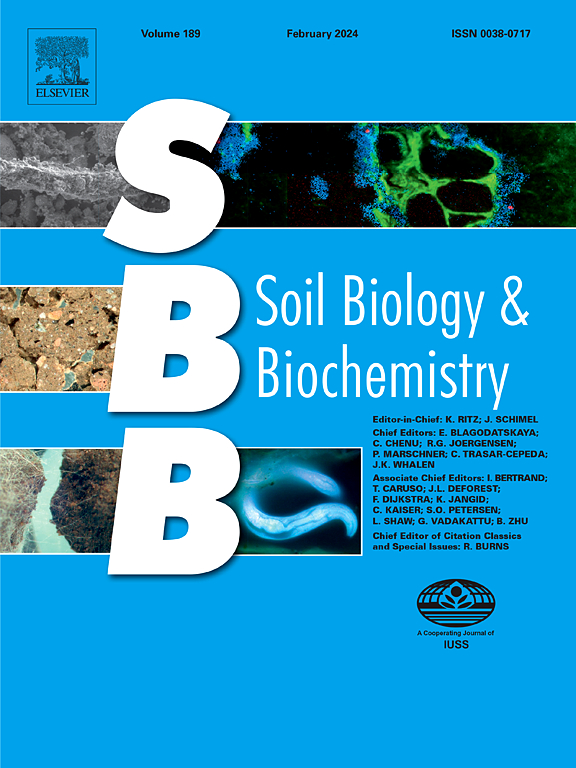干旱对温带森林土壤有机质积累的影响是由菌根菌丝而非细根调节的
IF 9.8
1区 农林科学
Q1 SOIL SCIENCE
引用次数: 0
摘要
干旱等极端气候事件预计会改变森林生态系统的土壤碳(C)和氮(N)循环。然而,人们对树根及其相关菌根真菌如何调节干旱的影响仍然知之甚少。在一个连续六年降雨量减少的橡树林中,我们使用不同网孔大小的中置容器进行了 144 天的原位培养,通过根途径和菌根菌丝途径区分了干旱对土壤有机碳和氮积累的影响。这些影响是在土壤有机质的不同稳定性组分(即颗粒有机质(POM)和矿物相关有机质(MAOM))中进行评估的。与根途径相比,干旱导致通过菌丝途径积累的土壤有机碳和氮更多。出现这种结果的原因是,由于分解率降低,菌丝途径导致的POM积累大于MAOM损失,而根系途径导致的POM损失大于MAOM积累,这主要归因于根系引诱效应的增强。此外,植物在应对干旱时通过菌丝途径利用了更多的土壤无机氮,而不是有机氮,这可能是不同可溶性组分中碳和氮变化不一致的部分原因。这些发现强调了在未来气候变化的背景下,区分根和菌根菌丝在调节土壤碳和氮过程中的不同作用的重要性。本文章由计算机程序翻译,如有差异,请以英文原文为准。


Mycorrhizal hyphae, but not fine roots modulate drought effects on soil organic matter accumulation in a temperate forest
Extreme climatic events, such as drought, are projected to alter soil carbon (C) and nitrogen (N) cycling in forest ecosystems. However, how the effects of drought are modulated by tree roots and their associated mycorrhizal fungi remains poorly understood. Over 144 days of in-situ incubation, using mesocosms with different mesh sizes in an oak forest subjected to six consecutive years of throughfall rain reduction treatment, we distinguished the drought effects on soil organic C and N accumulations via root-pathway and mycorrhizal hypha-pathway. These effects were assessed within different stability fractions of soil organic matter, i.e., particulate organic matter (POM) and mineral-associated organic matter (MAOM). Drought led to greater accumulations of soil organic C and N via the hypha-pathway compared to the root-pathway. This outcome arose because the hypha-pathway drove greater accumulation in POM than losses in MAOM due to reduced decomposition rates, whereas the root-pathway led to greater POM losses relative to MAOM accumulation, primarily attributable to an enhanced root priming effect. Moreover, plants utilized more soil inorganic N relative to organic N through the hypha-pathway in response to drought, which may partly account for the inconsistent changes in C and N within different labile fractions. These findings emphasize the importance of distinguishing divergent roles of roots and mycorrhizal hyphae in modulating soil C and N processes in the context of future climate change scenarios.
求助全文
通过发布文献求助,成功后即可免费获取论文全文。
去求助
来源期刊

Soil Biology & Biochemistry
农林科学-土壤科学
CiteScore
16.90
自引率
9.30%
发文量
312
审稿时长
49 days
期刊介绍:
Soil Biology & Biochemistry publishes original research articles of international significance focusing on biological processes in soil and their applications to soil and environmental quality. Major topics include the ecology and biochemical processes of soil organisms, their effects on the environment, and interactions with plants. The journal also welcomes state-of-the-art reviews and discussions on contemporary research in soil biology and biochemistry.
 求助内容:
求助内容: 应助结果提醒方式:
应助结果提醒方式:


